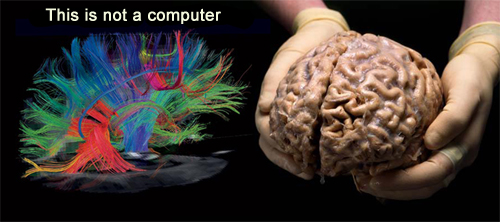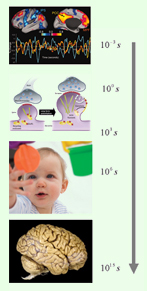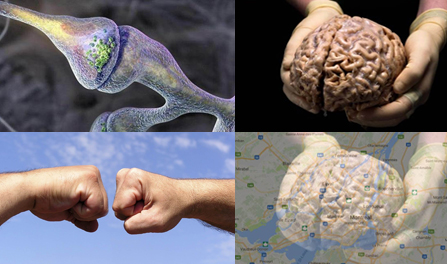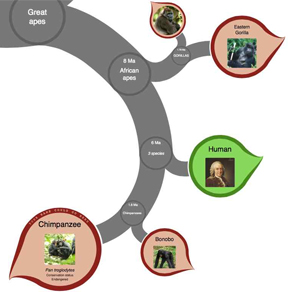Tuesday, 26 September 2017
The Brain: The History of an Organ Like No Other
 In the spring of 2017, I had to give a one-hour basic lecture about the human brain as part of a a free course for the general public at UPop Montréal. With so many different possibilities, deciding what approach to take in my lecture was no small challenge. In the end, I decided to start by trying to explain what the brain is not and dispelling a number of frequent misconceptions.
In the spring of 2017, I had to give a one-hour basic lecture about the human brain as part of a a free course for the general public at UPop Montréal. With so many different possibilities, deciding what approach to take in my lecture was no small challenge. In the end, I decided to start by trying to explain what the brain is not and dispelling a number of frequent misconceptions.
Most of the metaphors that compare the brain with a computer are pretty misleading, so I began by taking them apart, and then replacing them with others that better account for the selective, self-organizing dynamic processes that take place in the human brain and make the subtlest mental states possible. Thus, instead of comparing the brain to a computer, I used metaphors such as strange attractors in chaos physics and the complex flow patterns in a mountain stream—metaphors that can embrace both the long evolutionary history of the human brain, which accounts for its overall structure, and the neural networks that develop in an individual’s brain through a process of selection over that person’s lifetime. (more…)
From the Simple to the Complex | Comments Closed
Monday, 21 August 2017
Humans Are the Product of Dynamic Processes on Multiple Time Scales

Today I want to talk about dynamic processes that occur on some very different time scales in the human nervous system. To do so, I will describe four examples very briefly, referring to the two graphics in this post.
The first of these processes, represented at the bottom of each graphic, is the evolution of the human nervous system, which occurs on the longest of these time scales, measured in millions of years. Over these very long periods, sexual reproduction has accelerated the diversification of our nervous systems by regularly producing variants or mutations. Some of these variants have proved capable of viable structural couplings with certain environments and have thus enabled their lucky owners to pass these nervous systems down to their descendants. I am purposely avoiding saying that these nervous systems are “better adapted to their environment”, so as not to imply that part of this environment is unchanging or that there is always some optimal level of adaptation that organisms can achieve. To state it succinctly, evolution is more proscriptive than prescriptive: it of course eliminates certain mutations that are too incapable of viable coupling with their environment, but it “allows” all the rest. (more…)
Emotions and the Brain | Comments Closed
Thursday, 27 July 2017
The Damage Done by Social Isolation

John Cacioppo is a pioneer in the field of social neuroscience. He observes that people who are socially isolated were long thought to be suffering from some form of mental illness. But research done on this subject by Cacioppo and a number of other scientists over the past 10 to 20 years shows that social isolation is very much caused and/or aggravated by environmental factors in the broad sense, ranging from political decisions to economic ideologies. Not the least of these factors is the emphasis that our capitalist societies place on productivity. People who cannot find their place in this highly hierarchical, competitive system are too often regarded as “losers” whom an increasingly frayed social-safety network can no longer support adequately. (more…)
Mental Disorders | Comments Closed
Friday, 14 July 2017
Metaphors for the Brain’s Anatomy and Functioning

When I’m making presentations about the human brain to live audiences, the quick, easy method I often use to show them a three-dimensional model of a brain synapse is to hold my two fists facing each other, very close together, but not touching. One fist thus represents the axon of the pre-synaptic neuron, while the other represents a dendritic spine on the post-synaptic neuron. This macro model of a synapse is about 20 centimetres long.
In comparison, a real synapse in a mammalian brain is about 1 micron (one thousandth of a millimeter) long. This estimate includes the terminal button (the swelling at the tip of the axon), the dendritic spine (the swelling on a dendrite of the second neuron which receives the connection from the axon of the first), and the synaptic gap (the space between them). Into this gap, the axon of the pre-synaptic neuron releases its neurotransmitters, which immediately bind to the receptors in the membranes of the post-synaptic neuron’s dendritic spine. (more…)
From the Simple to the Complex | Comments Closed
Tuesday, 23 May 2017
Two “Trees of Life”
 This week I want to tell you about two great websites for learning about the genealogy of every living thing on planet Earth. The first is the evogeneao Tree of Life Explorer, and it uses an incredibly ingenious design that lets you click on any currently living species and trace back to the common ancestor that humans share with it. An animation then shows you where this common ancestor is located in the phylogenetic tree of all living things and tells you how many years ago this common ancestor lived. (more…)
This week I want to tell you about two great websites for learning about the genealogy of every living thing on planet Earth. The first is the evogeneao Tree of Life Explorer, and it uses an incredibly ingenious design that lets you click on any currently living species and trace back to the common ancestor that humans share with it. An animation then shows you where this common ancestor is located in the phylogenetic tree of all living things and tells you how many years ago this common ancestor lived. (more…)
Evolution and the Brain | Comments Closed







